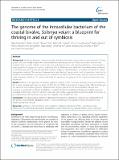| dc.contributor.author | Dmytrenko, Oleg | |
| dc.contributor.author | Russell, Shelbi L. | |
| dc.contributor.author | Loo, Wesley T. | |
| dc.contributor.author | Liao, Li | |
| dc.contributor.author | Roeselers, Guus | |
| dc.contributor.author | Sharma, Raghav | |
| dc.contributor.author | Stewart, Frank J. | |
| dc.contributor.author | Newton, Irene L. G. | |
| dc.contributor.author | Woyke, Tanja | |
| dc.contributor.author | Wu, Dongying | |
| dc.contributor.author | Lang, Jenna Morgan | |
| dc.contributor.author | Eisen, Jonathan A. | |
| dc.contributor.author | Cavanaugh, Colleen M. | |
| dc.contributor.author | Fontanez, Kristina M. | |
| dc.date.accessioned | 2014-12-08T19:35:50Z | |
| dc.date.available | 2014-12-08T19:35:50Z | |
| dc.date.issued | 2014-10 | |
| dc.date.submitted | 2014-04 | |
| dc.identifier.issn | 1471-2164 | |
| dc.identifier.uri | http://hdl.handle.net/1721.1/92232 | |
| dc.description.abstract | Background
Symbioses between chemoautotrophic bacteria and marine invertebrates are rare examples of living systems that are virtually independent of photosynthetic primary production. These associations have evolved multiple times in marine habitats, such as deep-sea hydrothermal vents and reducing sediments, characterized by steep gradients of oxygen and reduced chemicals. Due to difficulties associated with maintaining these symbioses in the laboratory and culturing the symbiotic bacteria, studies of chemosynthetic symbioses rely heavily on culture independent methods. The symbiosis between the coastal bivalve, Solemya velum, and its intracellular symbiont is a model for chemosynthetic symbioses given its accessibility in intertidal environments and the ability to maintain it under laboratory conditions. To better understand this symbiosis, the genome of the S. velum endosymbiont was sequenced.
Results
Relative to the genomes of obligate symbiotic bacteria, which commonly undergo erosion and reduction, the S. velum symbiont genome was large (2.7 Mb), GC-rich (51%), and contained a large number (78) of mobile genetic elements. Comparative genomics identified sets of genes specific to the chemosynthetic lifestyle and necessary to sustain the symbiosis. In addition, a number of inferred metabolic pathways and cellular processes, including heterotrophy, branched electron transport, and motility, suggested that besides the ability to function as an endosymbiont, the bacterium may have the capacity to live outside the host.
Conclusions
The physiological dexterity indicated by the genome substantially improves our understanding of the genetic and metabolic capabilities of the S. velum symbiont and the breadth of niches the partners may inhabit during their lifecycle. | en_US |
| dc.description.sponsorship | National Science Foundation (U.S.) (Grant 0412205) | en_US |
| dc.description.sponsorship | United States. Dept. of Energy. Office of Science (Contract DE-AC02-05CH11231) | en_US |
| dc.description.sponsorship | United States. Dept. of Energy. Joint Genome Institute | en_US |
| dc.publisher | BioMed Central Ltd | en_US |
| dc.relation.isversionof | http://dx.doi.org/10.1186/1471-2164-15-924 | en_US |
| dc.rights | Creative Commons Attribution | en_US |
| dc.rights.uri | http://creativecommons.org/licenses/by/4.0 | en_US |
| dc.source | BioMed Central Ltd | en_US |
| dc.title | The genome of the intracellular bacterium of the coastal bivalve, Solemya velum: a blueprint for thriving in and out of symbiosis | en_US |
| dc.type | Article | en_US |
| dc.identifier.citation | Dmytrenko, Oleg et al. “The Genome of the Intracellular Bacterium of the Coastal Bivalve, Solemya Velum: A Blueprint for Thriving in and out of Symbiosis.” BMC Genomics 15.1 (2014): 924. | en_US |
| dc.contributor.department | Massachusetts Institute of Technology. Department of Civil and Environmental Engineering | en_US |
| dc.contributor.mitauthor | Fontanez, Kristina M. | en_US |
| dc.relation.journal | BMC Genomics | en_US |
| dc.eprint.version | Final published version | en_US |
| dc.type.uri | http://purl.org/eprint/type/JournalArticle | en_US |
| eprint.status | http://purl.org/eprint/status/PeerReviewed | en_US |
| dc.date.updated | 2014-11-29T16:08:15Z | |
| dc.language.rfc3066 | en | |
| dc.rights.holder | Oleg Dmytrenko et al.; licensee BioMed Central Ltd. | |
| dspace.orderedauthors | Dmytrenko, Oleg; Russell, Shelbi L; Loo, Wesley T; Fontanez, Kristina M; Liao, Li; Roeselers, Guus; Sharma, Raghav; Stewart, Frank J; Newton, Irene LG; Woyke, Tanja; Wu, Dongying; Lang, Jenna; Eisen, Jonathan A; Cavanaugh, Colleen M | en_US |
| mit.license | PUBLISHER_CC | en_US |
| mit.metadata.status | Complete | |
